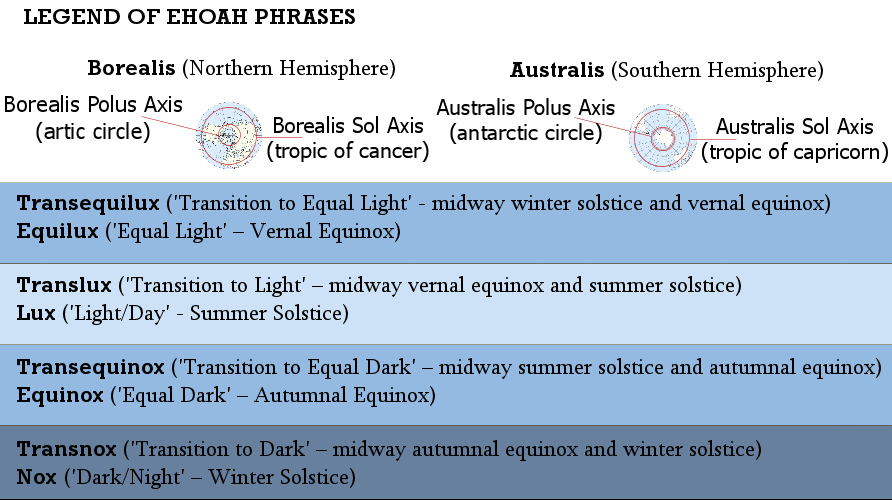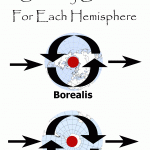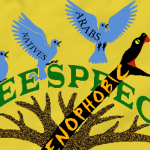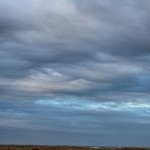F.N.A.E. articles are written with Ehoah phrases
What is Seasonally Occurring
During the transition between the Equinox & Solstice the earth is angling it’s northern hemisphere toward the sun. In Borealis the days are longer seeing the earth’s daily turning view of the sun higher and higher north; and for Australis the nights are longer with the daily turning view of the sun lower along the north horizon.
Within the Borealis Polus Axis it is 24hrs of daylight and getting milder, and within the Australis polus Axis it is 24hrs of night and getting colder.
South of the Borealis Polus Axis, with the exception of southern and western Europe, spring is finally in full effect with the first flowers of season springing up, planting is done in the gardens and fields, the watercourses and bodies are open, some species of reptiles are migrating, frogs are starting to be heard, birds are displaying and nesting their eggs, hibernating species are coming out, and when the gestation period for many species are nearing its end or the next generation is arriving.
Where the majority of earth’s population is (at and just north of the Borealis Sol Axis – Tropic of Cancer with the addition of Southern & Western Europe) It is early summer, with adult leaves on the trees, insects in hyper pollination mode, frogs in chorus, mammal offspring are steady on their feet, and nests filled with chicks.
For the Tropics, this is when the Tropical Rain Belt is over the equator, moving toward the Borealis Sol Axis. As well as reaching East and Southeast Asia where the rains are in full effect.
South of the equator it is overall getting darker, colder and the precipitation is lessening.
What Are The Seasonal Customs
In Borealis, most of the temperate climes are celebrating the full effects of spring arriving with planting of seeds and seedlings, and getting outside more often for longer periods of time. In the warmer climes planting and seeding are completed, in some regions the first harvest has already been brought in and the second harvest sowed. For both temperate and warmer climes fertility is a common theme with smaller species of wildlife performing mating rituals and the earth is symbolized as being fertile with all the new life about. Humans cue off of these surroundings with fertility type dances (most popularly the maypole), rituals for a good harvest to come, maiden lead opening ceremonies, phallic icons, and secret admirer gifts.
Various activities around this time of year include: celebrating the seasonal flooding of rivers as the “earth’s menstrual cycle”, tree planting parties, outdoor music performances, outdoor cooking/barbecues, foliage costumes, floral parades, branches placed infront of entries of homes and livestock shelters for protection where at the end of the wheat harvest they are removed to use for baking the first bread, bonfires, gifts of spring flowers and sweets (often anonymous), and pilgrimages to sacred wells/springs.
In Australis the harvest has come in, feasts are made, and festivities of light are had.
Various activities in Australis include: bonfires, ancestor veneration, planning for eventual death (as to make it a smooth transition for loved ones), death themed decorations, visiting graves/remembering the dead, seed exchanges from harvest, Virid-os (green bones) seasonal character is at festivities challenging taboos, exploring the different nocturnal creatures that will be more present in the darker months ahead, and learning lore of the land.
BOREALIS
|
CELEBRATION |
GENERAL DATE |
SPECIFIC DATE |
CALENDAR |
REGION OF ORIGIN |
CULTURE |
|
Mid June |
when the Brahmaputra river is in spate |
Indian national calendar and Older Regional Calendars |
South Asia |
Indian |
|
May Day, Walpurgis Night, Beltane
|
Early May |
April 30th/May 1st or full moon nearest this point |
Western Europe |
Western Nations, German, Celtic |
|
|
Translux |
Early May |
45 days after Equilux/45 days before Lux |
Earth |
Saegoah |
|
|
Mid April |
After ground is thawed |
North America |
North American |
AUSTRALIS
|
CELEBRATION |
GENERAL DATE |
SPECIFIC DATE |
CALENDAR |
REGION OF ORIGIN |
CULTURE |
|
Late April |
April 30th |
North Western Europe |
Celtic |
||
|
Early May |
45 days after Equinox/45 days before Lux |
Earth |
Saegoah |
||
|
Matariki, “Māori New Year” |
late May or early June |
first rising of the Pleiades Either celebrating it immediately, or until the rising of the next full moon, or the dawn of the next new moon |
Unknown |
Polynesia |
Māori |














